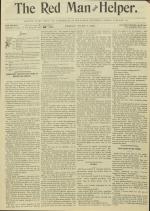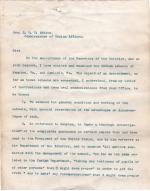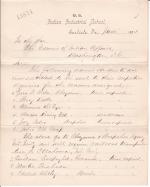Student information card of John D. Miles, a member of the Cheyenne Nation, who entered the school on October 27, 1879 and ultimately departed on July 6, 1888.


Student information card of John D. Miles, a member of the Cheyenne Nation, who entered the school on October 27, 1879 and ultimately departed on July 6, 1888.

Page one opened with a teacher identified as A.J.S. (Alfred J. Standing) reminiscing about his time teaching Native Americans before he came to Carlisle. Also on the page was an article signed by "G. Le R. B." (George Le Roy Brown) on the civilization of the Indians, comparing it to the conquests of the Roman Empire and its assimilation of less…

The first article is by John Downing (Cherokee), titles “Learning How to Use Bad Things.” In which he writes about alcohol and the benefits of being nice to the people of the United States, and a letter from Moses Nonway to his mother asking on the health of his people and reflecting on their poverty. The next page contained a list of small…

A description of this document is not currently available.
Note: This issue was also published as The Red Man (Vol. 16, No. 49).
![John D. Miles [version 1], c.1881 John D. Miles [version 1], c.1881](/sites/default/files/styles/views_taxonomy/public/image-photo/NAA_74401.jpg?itok=FS9LBMKN)
Studio portrait of John D. Miles.
![John D. Miles [version 2], c.1881 John D. Miles [version 2], c.1881](/sites/default/files/styles/views_taxonomy/public/image-photo/CCHS_PA-CH1_087a.jpg?itok=R6ZzWxCA)
Studio of John D. Miles.
![Thirteen male student printers [version 1], c.1886 Thirteen male student printers [version 1], c.1886](/sites/default/files/styles/views_taxonomy/public/image-photo/NAA_73294.jpg?itok=yIKDh9KB)
Studio portrait of thirteen male students, all wearing school uniforms. The caption of this and other copies identifies them as working in the print shop.
Other copies identify the students. They are:
1. Bennie Thomas, 2. Lorenzo Martinez, 3. Willie Butcher, 4. C. P. Cornelius, 5. Dennison Wheelock, 6. Samuel Townsend…
![Thirteen male student printers [version 2], c.1886 Thirteen male student printers [version 2], c.1886](/sites/default/files/styles/views_taxonomy/public/image-photo/CIS-P-0077.jpg?itok=3K3kAVKl)
Studio portrait of thirteen male students wearing school uniforms.
The printed note on the reverse side reads: 1. Bennie Thomas, Pueblo Tribe, 2. Lorenzo Martinez, Pueblo, 3. Willie Butcher, Chippewa, 4. C. P. Cornelius, Oneida, 5. Dennison Wheelock, Oneida, 6. Samuel Townsend, Pawnee, 7. Richard Davis, Cheyenne…

Telegram from Commissioner of Indian Affairs Ezra Hayt to the Agent of Cheyenne and Arapaho Agency John D. Miles which tells Miles that he has permission to recruit 25 young people to be sent to Carlisle.
Hayt orders Miles to have a physician certify these young people's health then send them to Winfield, Kansas to meet Pratt on…

John D. Miles, Agent for the Cheyenne and Arapaho Agency, writes to Commissioner of Indian Affairs Ezra Hayt describing efforts to support the recruitment of young people for the Carlisle Indian School. He also refers to the situation having been "somewhat unsettled" recently due to a proposed reduction in rations. Transcript included. …

Richard Henry Pratt reports on the buildings, grounds, industrial curriculum, and overall aims of the Carlisle Indian Training School. The report includes descriptions of building sizes and purposes, industrial capabilities, and the efforts then underway to establish Congressional approval for the school's continuation. Also included are…

Richard Henry Pratt informs Commissioner of Indian Affairs R. E. Trowbridge that the Cheyenne & Arapaho Agent John D. Miles would like to send 25 students from his agency to the Carlisle Indian School. Miles added that he'd like several chiefs, including Northern Cheyenne Chief Little Chief, to accompany the party of students and that the…

Richard Henry Pratt informs Acting Commissioner of Indian Affairs E. J. Brooks that during their recent visit the Kiowa, Comanche, Apache and Wichita chiefs told him that they would like more of their children enrolled at the school. In particular, Pratt writes that he promised Chief Tsodearko to intercede with the Bureau and ask for permission…

Richard Henry Pratt writes to Acting Commissioner of Indian Affairs E. M. Marble regarding three former Florida prisoners that should be returned home, escorted by Agent Miles. The first is going to die soon because of an accident suffered while playing baseball, and his chiefs want him to die at home. The second is the son of the late Cheyenne…

Richard Henry Pratt requests that the Commissioner of Indian Affairs authorize Agent Miles' expenses incurred while transporting a party of six Cheyenne and Arapaho chiefs and their children as well as Daniel Tucker from the Carlisle Indian School to Philadelphia and Washington, D.C. Tucker and the chiefs' children are all Carlisle students.…

John D. Miles, Agent for the Cheyenne and Arapaho Agency, tells Richard Henry Pratt that his agency gave students cattle to take care of over vacation. As students did not know about the money and effort involved in caring for the animals, Miles relays a suggestion from John Holmes Seger (from the Arapaho school) that male students sell their…

Richard Henry Pratt recommends Indian Agent John D. Miles for the new position of Inspector of Schools in the Indian Service.

Richard Henry Pratt informs the Office of Indian Affairs that he has hired Obadiah G. Given as the Carlisle Indian School physician. Pratt details how he came to the decision as well as Given's salary.

Notice of the death of White Shield is received by Richard Henry Pratt from U.S. Indian Agent John D. Miles. As a result Pratt requests authorization for sending home his son Harvey in order to provide help to the family. In addition, Pratt requests sending home two young Arapaho girls with Harvey as a chaperone.

Richard Henry Pratt forwards a letter from John D. Miles about establishing an Indian School at Fort Dodge, Kansas focusing on cattle raising. Pratt writes that in his opinion the idea is not a good idea due to being located near reservations as well as the camp influences of Dodge City.

T. S. Childs makes a report to the Office of Indian Affairs on Carlisle Indian School and the Indian Training School at the Hampton Institute. Childs report was prompted by complaints made against the Hampton Institute related to the health and discipline of students. Childs report focuses mostly on Hampton while examining Carlisle in order to…

Richard Henry Pratt informs the Office of the Indian Affairs of the 60 students who are entitled to return to their home at the end of the school term due to the expiration of their enrollment or sickness.

These materials include a cover letter and a Descriptive Statement of Pupils regarding 61 individuals discharged from the Carlisle Indian School and transferred back to their homes in the San Carlos, Laguna, Wallace, Isleta, Quapaw, Eufaula, Omaha, Winnebago, Nez Perce, Crow, Kiowa and Comanche, Cheyenne and Arapaho, Ponca, Rosebud, and Pine…

Richard Henry Pratt provides a recommendation for John D. Miles to fill the position of Superintendent of the Haskell Institute. Pratt writes that Miles had the best schools of any agency he dealt with and that Miles would be the best man for the job. Pratt ends by noting that only someone who is willing to reside at the school and give it…